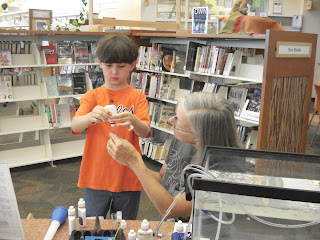All the business publications say that you need to be able to reinvent yourself in your career to stay fresh. I find that this is very true if you want to stay in the same organization for any length of time. My most recent career iteration came in the form of horseshoe crabs.
We are now raising horseshoe crabs at the Whiteford Branch of the Harford County Public Library and are the first library to do so under the "
Raising Horseshoe crabs in the classroom project" of the Maryland Department of Natural Resources. This has been a huge boost for librarians and patrons alike with over 1,000 people visiting the tank in the first month. The tank sits right in the middle of the reference desk and gives librarians a wonderful opportunity to engage in informal science education. We will be raising the crabs for a year and then releasing them into the ocean at Sandy Point State Park in May. In the meantime, children in Grades 3-8 will help maintain the tank and submit data to the State.
Scientific literacy: Parents and children. The latent interest in science among both children and adults has been a revelation to me. Most interesting is watching the interactions between parents and children. The parents seem to play an extremely important role in helping children process new information by providing
context to the science encounter.
"Remember, we saw horseshoe crabs on the beach last summer" is a common theme.
The children also seek to validate the importance of the experience by showing their parents.
"Dad, come look at the horseshoe crabs" (this a a point where parents can make or break the experience.)
The cultural (social) validation (science is important, curiosity should be encouraged) seems to be corroborated by some scientific studies (Callanan, 2001).
Active Science and the Library We are trying to make the horseshoe crab program an active scientific project for our patrons. We have journals in which they can note observations. The children actively are involved in performing chemical tests on the saltwater tank (we test for salinity, ammonia, nitrate, nitrite, pH and temperature) and in feeding the crabs. So far, the participants in the testing and feeding process have been much more likely to monitor the progress of the crabs on subsequent visits to the library. We are exploring other ways to replicate this active participation in science and are exploring several "Citizen Science" projects to participate in.
Raising Horseshoe Crab (awareness) takes a community. In addition, adults have been very active in supporting the educational process as well. One family brought in horseshoe crab shells that they collected from the beach. Another brought in personal photos of the annual horseshoe crab mating that showed the vast numbers of eggs deposited and the many birds attracted to this food source. Others have told their friends and neighbors about the project at the library.
New Directions for Beginnersmind I hope to make this blog a record of some of the successes and failures of science in public libraries. Over the weeks, I will be adding links to sources of Citizen Science activities and of course keep everyone up-to-date on how the horseshoe crabs are doing. I also hope to identify some areas of potential research into science literacy and the role public libraries can play.
I also hope you will share any ideas and resources you find.
Callanan, M., & Jipson, Jennifer, L. (2001). Explanatory Conversations and Young Children’s Developing Scientific Literacy. In K. Crowley, C. D. Schunn, & T. Okada (Eds.), Designing For Science: Implications from Everyday, Classroom and Professional Settings (pp. 21–49). Mahwah, New Jersey: Lawrence Erlbaum Associates.



